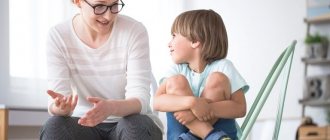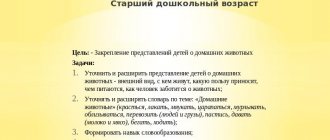Master class “Using the syncwine method”
Master class “Using the syncwine method in working on the development of speech in preschool children”
Ivanova Lyudmila Gennadievna , teacher of the highest qualification category MBDOU d/s “Golden Fish” p. Pechersk, Smolensk district, Smolensk region
Goal: to give an idea of the innovative method of speech development “Sinquain”, the importance of this method in enriching and activating the verbal dictionary, the dictionary of adjectives, the grammatical design of phrases, and the development of associative and visual-figurative thinking. Show the significance of this technology in other types of activities.
Master class plan
- I. Theoretical part:
- —What is “Sinquain?”
- —Relevance of “Sinquain”;
- —Scientific concept and rules for compiling “Sinquain”;.
- II. Practical part:
- —Joint work with teachers with display on the screen.
- —Discussion of the results obtained.
III. Summarizing.
Advertising message
Good afternoon, dear jury, colleagues! I'm glad to see you at the master class. I hope that our event will be interesting, useful for you, and most importantly will bring you a lot of positive emotions.
1 slide
I would like to ask you a riddle:
Creative, energizing. Develops, enriches, clarifies. Helps you study. Method.
This is syncwine. And I suggest you play cinquain, like in childhood. To do this, I invite my colleagues sitting in the front row.
Questions are prepared on the sheet. Each player writes any answer, then wraps it up and the players exchange pieces of paper (to avoid confusion, they pass it around in a circle). At the end of the game, everyone unfolds the piece of paper that they have and reads it out in turn.
Questions that are pre-written on a piece of paper.
- - Who?
- - With whom?
- - Where?
- - When?
- - What they were doing?
- - What did they say?
- - How did it all end?
(the “nonsense” that came out during the game is read out).
I thank my colleagues for their help. Go to your seats.
- Theoretical part.
Dear colleagues, I would like to introduce you to the syncwine technique. Relatively recently, teachers began to use syncwine to enhance cognitive activity and began to use it as a method of developing figurative speech, allowing them to quickly get results.
2 slide
The relevance and expediency of using syncwine is explained by the fact that, first of all:
- – new creative intellectual opportunities open up;
- – contributes to the enrichment and updating of the dictionary;
- – is a diagnostic tool and is carried out as part of the passage of a certain lexical topic;
- – has a complex effect (develops speech, memory, attention, thinking)
- – used to consolidate the topic studied;
- – is a gaming technique;
- – compiling a syncwine is used for reflection, analysis and synthesis of the information received.
3 slide
When using syncwine creatively in the classroom, preschoolers perceive it as an exciting game - after all, composing is fun, useful and easy. But you need to remember that it is necessary to compose a syncwine only on topics well known to children and be sure to show an example.
The most important thing: Cinquain - everyone can do it!
When should you start getting acquainted with this technique?
– With older children.
4 slide
The word "cinquain" comes from the French word for "five" and means "a poem of five lines." Cinquain is an unrhymed five-line poetic form written in accordance with certain rules.
At the beginning of the 20th century, the cinquain form was developed by the American poet Adelaide Crepsi, who relied on her acquaintance with Japanese haiku and tanka miniatures. Cinquains were included in her posthumous collection of poems, published in 1914.
5 slide
The rules for composing a syncwine are as follows: a syncwine consists of five lines and its shape resembles a Christmas tree.
- line – Title. One word, usually a noun, reflecting the main idea (Who, what?);
- string – Description. Two words, adjectives, describing the main idea (Which, which, which, which?);
- line – Action. Three words, verbs that describe actions within the topic (What is he doing, what are they doing?);
- line - A phrase of several words showing an attitude to the topic, expressing the personal attitude of the author of the syncwine to the subject or object being described;
- string – Synonym for topic name. One summary word characterizing the essence of a subject or object (generalizing word). Conclusion, result, association.
So, in order to put this technique into practice, we must learn it ourselves. Let's start composing a joint syncwine, and you will easily remember this rule. Let's talk about personal things. What worries every woman? Figure, weight......
(I write the topic and answers on the board)
I read the entire sequence.
- Practical part.
Dear colleagues, I propose to use the acquired knowledge using specific examples.
(I invite 6 people to the tables). I suggest you make syncwines based on the drawings that our children drew.
While the participants delved into creativity, I will ask you, dear viewers, to guess the syncwin riddles.
And our competent jury will create a cinquain riddle, which you and I will all have to guess.
I hope our colleagues are ready. Please come in.
Let's thank our colleagues for such wonderful syncwines.
All syncwines are read out.
Dear colleagues, we are now at the final stage of our master class, and I propose to evaluate the results of our joint work.
As mentioned earlier, one of the most common reflection techniques is syncwine.
Let's summarize our work today and make a syncwine on the topic: “Master class.”
(on the board there is a syncwine diagram drawn in advance. I write down the best answers and read out what happened)
Master Class
Relevant, creative Excites, unites, disciplines Look at others and show yourself Work experience
I truly thank you for our joint work; I think that the method used today in the master class will help you in the future, achieve the desired results in all types of activities and will become a highlight in working with children. So, go for it, dear teachers. Good luck in your creativity. Maybe we will raise more than one poet with you.
Thank you for your attention!
Material submitted for the competition “Fun Logic”
A reminder on how to compose a syncwine
Did you like the competition entry?
Don't forget to press the social media buttons
and leave a comment!!!
What is syncwine?
He who thinks clearly speaks clearly. Ancient saying
Psychologists and practicing teachers note that older preschoolers often have speech impairments, a poor vocabulary, children do not know how to compose a story from a picture, retell what they read, and it is difficult for them to learn a poem by heart. Compiling a syncwine is one way to partially solve these problems. Sinkwines are often used by modern teachers for classes in kindergarten and school lessons. Already at preschool age, you can teach children to compose syncwines in the form of a game.
Children Beloved, affectionate Play, delight, touch Children are the flowers of life Happiness
These lines are similar to the Japanese lyric poetry of Hoku and Tanka. Hoku is a Japanese tercet and tanka is a quintet, where the words are minimal, but each word carries enormous information and emotional overtones. But this is not Japanese poetry. This is syncwine. What does this unusual word mean?
Cinquain is a French word that means “poem of five lines.” The cinquain form was developed by the American poet Adelaide Crapsey, who relied on Japanese poetry - hoku (haiku). This is a small verse, consisting of three lines without rhyme, a lyric poem characterized by brevity, which is read very slowly.
For example:
Kareeda ni karasu no tomarikeri aki no kuree. A raven sits alone on a bare branch. / Autumn evening.
Cinquain, like hoku, carries a certain emotional connotation. By composing a syncwine, each of its components realizes its skills and abilities. If the cinquain is compiled according to the rules, then it will definitely turn out to be emotional. In addition to the traditional one, there are different types of syncwines:
- reverse syncwine,
- cinquain butterfly,
- mirror syncwine.
Cinquain is an unrhymed poem, which today is a pedagogical technique aimed at solving a specific problem.
Relatively recently, teachers began to use syncwine to enhance cognitive activity and began to use it as a method of speech development.
To compose a syncwine, you need to learn to find the main elements in the text, in the material, draw conclusions and conclusions, express your opinion, analyze, generalize, isolate, combine and briefly present.
We can say that this is a flight of thought, free mini-creativity, subject to certain rules.
Rules for compiling syncwine:
- The first line of a syncwine is a title, a topic, consisting of one word (usually a noun meaning the object or action in question).
- The second line is two words. Adjectives. This is a description of the characteristics of an object or its properties, revealing the theme of syncwine.
- The third line usually consists of three verbs or gerunds describing the actions of the subject.
- The fourth line is a phrase or sentence consisting of several words that reflect the personal attitude of the author of the syncwine to what is said in the text.
- The fifth line is the last. One word is a noun to express one’s feelings, associations associated with the subject discussed in the syncwine, that is, it is the author’s personal expression on the topic or a repetition of the essence, a synonym.
It is assumed that with preschool children, strict adherence to the rules for compiling syncwine is not necessary.
It is possible that in the fourth line the sentence may consist of 3 to 5 words, and in the fifth line, instead of one word, there may be two words. Other parts of speech are also allowed.
Example of syncwine “Our group”.
Our group is cheerful, friendly. We study, play, dance. Our favorite region. We are friendly!
Synquains will help quickly and effectively teach a child synthesis, generalization and analysis of various concepts. In order to correctly, fully, and competently express his thoughts, a child must have a sufficient vocabulary. Therefore, work must begin with expanding and improving the dictionary. The richer the child’s vocabulary, the easier it will be for him to construct not only a syncwine, but also to retell the text and express his thoughts.
Is it possible to teach syncwines to children who cannot yet read?
Why not? Of course you can. For children who are just learning letters and cannot read, you can offer oral compilation of syncwine with question words. About who about what? Which, which, which? What did you do, what did you do? With the help of leading questions, children learn to highlight the main idea, answer questions and, according to a certain algorithm, create their own oral non-rhyming poems.
Syncwine algorithm for children who do not yet know how to read: Legend:
- words-objects (nouns)
- words-signs (adjectives)
- action words (verbs)
- words-objects (nouns)
Compiling a syncwine is a form of free creativity, which is aimed at developing the ability to find the most important and significant features in a large flow of information, analyze, draw conclusions, and formulate one’s statements multiple times.
Composing a syncwine is like a game, because composing is fun, useful and easy!
Interest in the world around us develops, speech, thinking, memory develop.....
Teachers who use the syncwine method in their work have noticed that syncwine promotes the development of critical thinking.
One of the goals when composing a syncwine is to achieve the ability to highlight the main idea of the text, as well as briefly express your thoughts. “The meaning of a word is a phenomenon of thinking,” wrote the famous Soviet psychologist L.S. Vygotsky in his work “Thinking and Speech”.
Conclusions about syncwine:
- Cinquain is a French five-line poem similar to Japanese poems.
- Sinkwine helps improve your vocabulary.
- Sinkwine teaches short retelling.
- Sinkwine teaches you to find and highlight the main idea in a large volume of information.
- Writing a syncwine is a creative process. This fun activity helps children express themselves through writing their own unrhymed poems.
- Everyone can make a syncwine.
- Sinkwine helps develop speech and thinking.
- Sinkwine facilitates the process of mastering concepts and their content.
- Sinkwine is also a way of control and self-control (children can compare syncwines and evaluate them).
PRE-SCHOOL EDUCATION: Cinquain is one of the effective methods for developing the speech of a preschooler
What is its effectiveness and significance?
- Firstly, its simplicity. Anyone can make a cinquain.
- Secondly, in composing a syncwine, every child can realize his creative and intellectual capabilities.
- Sinkwine is a gaming technique.
- Compiling a syncwine is used as the final task for the material covered.
- Compiling a syncwine is used for reflection, analysis and synthesis of the information received.
Examples of some syncwines compiled by preschoolers:
1. Kitten Black, fluffy Plays, sleeps, eats He is my friend Pet
2. House Big, beautiful Protects, warms Needed by all people Shelter
3. Watermelon Round, tasty Rolling, growing, ripening Watermelon is a large berry. Summer
Let's try to make a “Family” syncwine together
- Family
- What is she like? (beautiful, strong, friendly, cheerful, big)
- What is she doing? (proud, cares, helps, loves, hopes...)
- Family sentence, aphorism or proverb. (The whole family is together - and the soul is in place. The family agrees, this is how things are going well. I love my family.)
- Synonym, or, as another way to call family (Unit of society. My home! Beloved. Dear).
When compiling a syncwine with preschoolers, you need to remember that it is necessary to compose a syncwine only on topics that are well known to children and be sure to show a sample.
If compiling a syncwine is difficult, you can help with leading questions.
You need to be prepared for the fact that not all children may like composing a syncwine, because working on it requires a certain understanding, vocabulary and the ability to express their thoughts. Therefore, it is necessary to help and encourage children’s desire to compose a syncwine or answer questions. Gradually, children will get used to the rules of writing unrhymed poems, and composing them will turn into a game. And unnoticed by the children themselves, playing cinquain will become a fun and entertaining activity for them. “Even an instant insight can become the first spark from which sooner or later the flame of creative search will ignite,” wrote V. Shatalov. Children will be proud of their achievements!







